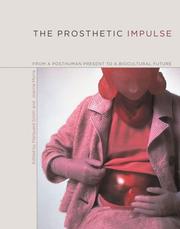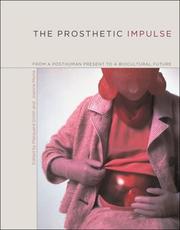| Listing 1 - 6 of 6 |
Sort by
|
Book
Abstract | Keywords | Export | Availability | Bookmark
 Loading...
Loading...Choose an application
- Reference Manager
- EndNote
- RefWorks (Direct export to RefWorks)

ISBN: 9780262195300 0262195305 Year: 2006 Publisher: Cambridge, Mass. : MIT Press,
Abstract | Keywords | Export | Availability | Bookmark
 Loading...
Loading...Choose an application
- Reference Manager
- EndNote
- RefWorks (Direct export to RefWorks)
"The thirteen original essays in The Prosthetic Impulse reassert the phenomenological, material and embodied nature of prosthesis without dismissing its metaphorical potential. They examine the historical and conceptual edge between the human and the posthuman - between flesh and its accompanying technologies. Rather than tracking the transformation of one into the other, these essays address this borderline instead, and the delicate dialectical situation in which it places us. Concentrating on this edge, the collection demonstrates how the human has been technologized and technology humanized."--BOOK JACKET.
Amputees --- Biomedical engineering --- Human body --- Prosthesis --- Medical innovations. --- Amputés --- Génie biomédical --- Corps humain --- Prothèses --- Médecine --- Psychology --- Social aspects. --- Technological innovations --- Psychologie --- Aspect social --- Innovations --- Body, Human --- Prostheses and Implants --- Biomedical Technology. --- Human Body. --- Medicine in Art. --- Metaphor. --- Technological innovations. --- psychology. --- Amputés --- Génie biomédical --- Prothèses --- Médecine

ISBN: 0262693615 9780262693615 Year: 2006 Publisher: Cambridge MIT
Abstract | Keywords | Export | Availability | Bookmark
 Loading...
Loading...Choose an application
- Reference Manager
- EndNote
- RefWorks (Direct export to RefWorks)
Où finit le corps ? Explorer la frontière matérielle et métaphorique entre la chair et les technologies qui l'accompagnent. La prothèse - indiquant un ajout, un remplacement, une extension, une amélioration - est devenue une sorte de métaphore polyvalente pour les interactions du corps et de la technologie. Préoccupé par la cybernétique, la technologie de greffe, l'intelligence artificielle et la réalité virtuelle, entre autres développements culturels et scientifiques, "la prothèse" évoque une condition post-humaine. En réponse à cela, les 13 essais originaux de The Prosthetic Impulse réaffirment la nature phénoménologique, matérielle et incarnée de la prothèse sans négliger son potentiel métaphorique. Ils examinent la frontière historique et conceptuelle entre l'humain et le posthumain, entre la chair et les technologies qui l'accompagnent. Plutôt que de suivre la transformation de l'un en l'autre, ces essais abordent cette frontière et la délicate situation dialectique dans laquelle il se situe. Se concentrant sur cet avantage, la collection montre comment l'homme a été technologisé et la technologie humanisée. L’approche éclectique adoptée par The Prosthetic Impulse s’appuie sur des disciplines allant des études de genre, de la philosophie à la culture visuelle, en passant par la psychanalyse, la cyberthéorie et la phénoménologie. La première section, "La carnalité: entre la phénoménologie et le bioculturel", est centrée sur l’organique et décrit un corps qui, par sa matérialité même, est toujours et déjà prothétique. La deuxième section, "Assemblage: internalisation. Externalisation", examine les qualités technologiques et les particularités de la prothèse et soulève des questions sur la manière dont le film, la photographie, l'IA, le dessin et la littérature - la représentation même - peuvent être situés dans le cadre d'une discours prothétique. Pris ensemble, les essais suggèrent que la prothèse est à la fois matérielle et métaphorique. "C'est juste une question de penser aux limites inélégantes", écrivent les rédacteurs en chef, "et de les vivre à merveille."
#SBIB:39A9 --- Human body --- Prosthesis --- Medical innovations --- Prostheses and Implants --- Amputees --- Biomedical Technology --- Human Body --- Medicine in Art --- Metaphor --- Body, Human --- Human beings --- Body image --- Human anatomy --- Human physiology --- Mind and body --- Innovations, Medical --- Medicine --- Medical technology --- Technological innovations --- Prostheses --- Prosthetics --- Moulage in medicine --- Surgery, Plastic --- Artificial organs --- Biomedical materials --- Implants, Artificial --- Parabole --- Figures of speech --- Reification --- Medische antropologie / gezondheid / handicaps --- Social aspects --- psychology --- Innovations --- Réalité virtuelle --- Technologie --- Intelligence artificielle --- Corps humain, thème --- Machine (thème) --- Morale --- Philosophie --- Esthétique --- Anatomie
Book
ISBN: 1786723050 1786733056 1350986836 9781350986831 9781786733054 9781780762067 9781780762074 Year: 2017 Publisher: London, England : London, England : I.B. Tauris & Co. Ltd, Bloomsbury Publishing,
Abstract | Keywords | Export | Availability | Bookmark
 Loading...
Loading...Choose an application
- Reference Manager
- EndNote
- RefWorks (Direct export to RefWorks)
"Sigmund Freud spent the final year of his life at 20 Maresfield Gardens, London, surrounded by all his possessions, in exile from the Nazis. The long-term home and workspace he left behind in Berggasse 19, Vienna is a seemingly empty space, devoid of the great psychoanalyst's objects and artefacts. Now museums, both of these spaces resonate powerfully. Since 1989, the Freud Museum London has held over 70 exhibitions by a distinctive range of artists including Louise Bourgeois, Sophie Calle, Mat Collishaw, Susan Hiller, Sarah Lucas and Tim Noble and Sue Webster. The Sigmund Freud Museum Vienna houses a small but impressive contemporary art collection, with work by John Baldessari, Joseph Kosuth, Jenny Holzer, Franz West and Ilya Kabakov. In this remarkable book, Joanne Morra offers a nuanced analysis of these historical museums and their unique relationships to contemporary art. Taking us on a journey through the 'site-responsive' artworks, exhibitions and curatorial practices that intervene in the objects, spaces and memories of these museums, Joanne Morra offers a fresh experience of the history and practice of psychoanalysis, of museums and contemporary art."--
Artists and museums. --- Freud, Sigmund, --- Museums. --- Freud Museum (London, England) --- Sigmund Freud Museum (Vienna, Austria)

ISBN: 0415326419 Year: 2005 Publisher: London ; New York Routledge
Abstract | Keywords | Export | Availability | Bookmark
 Loading...
Loading...Choose an application
- Reference Manager
- EndNote
- RefWorks (Direct export to RefWorks)

ISBN: 0719057507 0719057515 Year: 2000 Publisher: Manchester Manchester university press
Abstract | Keywords | Export | Availability | Bookmark
 Loading...
Loading...Choose an application
- Reference Manager
- EndNote
- RefWorks (Direct export to RefWorks)
| Listing 1 - 6 of 6 |
Sort by
|

 Search
Search Feedback
Feedback About UniCat
About UniCat  Help
Help News
News